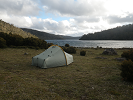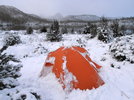I have made a post or two here about water treatment.
I have posted about viruses previously as they are not filtered easily.
Now I'd like to mention algae, I have not been able to find much information on how to identify contaminated water sources nor did I find information on how to get rid of toxins, and I also did not find much information about their prevalence in Australian water sources in the bush.
I am wondering whether we should be concerned about that.
My main questions are
1. How to identify water with algal blooms/toxins, does it suffice to look at the color of water?
2. Is there a reliable way to treat water for algal toxins? do activated carbon filters suffice?
3. Is there any concern in Australia about algal toxins?
Thanx to anyone who answers, sorry if I'm making too many posts abotu water filteration, this is probably the last one.
Algal toxins in water sources
Forum rules
The place for bushwalking topics that are not location specific.
The place for bushwalking topics that are not location specific.
13 posts
• Page 1 of 1
- fiftyeight
- Nothofagus gunnii

- Posts: 10
- Joined: Tue 04 Mar, 2014 11:10 am
- Region: Tasmania
- Gender: Male
Re: Algal toxins in water sources
fiftyeight wrote:...sorry if I'm making too many posts abotu water filteration, this is probably the last one.
Never apologise for asking questions.
One foot in front of the other.
-

michael_p - Athrotaxis selaginoides

- Posts: 1389
- Joined: Sun 15 Nov, 2009 6:58 pm
- Location: Macarthur Region of Sydney.
- Region: New South Wales
- Gender: Male
Re: Algal toxins in water sources
1. How to identify water with algal blooms/toxins, does it suffice to look at the color of water?
You can usually see an active bloom. If the bloom has died out and just the toxin remains you will not always be able to smell/taste/see it.
2. Is there a reliable way to treat water for algal toxins? do activated carbon filters suffice?
Reliable: RO, distillation
Relistically most journal articles I found support the efficacy of activated carbon filters.
3. Is there any concern in Australia about algal toxins?
Yes.
Don't drink from the murray and inland reservoirs.
Algae cannot grow well in near freezing water. I wouldn't be worried about algae in the alpine areas of tas/vic/NSW in winter/spring.
My rule of thumb = if the water is unpleseant unfiltered don't drink it even when "cleaned"
You can usually see an active bloom. If the bloom has died out and just the toxin remains you will not always be able to smell/taste/see it.
2. Is there a reliable way to treat water for algal toxins? do activated carbon filters suffice?
Reliable: RO, distillation
Relistically most journal articles I found support the efficacy of activated carbon filters.
3. Is there any concern in Australia about algal toxins?
Yes.
Don't drink from the murray and inland reservoirs.
Algae cannot grow well in near freezing water. I wouldn't be worried about algae in the alpine areas of tas/vic/NSW in winter/spring.
My rule of thumb = if the water is unpleseant unfiltered don't drink it even when "cleaned"
Men wanted for hazardous journey. Low wages, bitter cold, long hours of complete darkness. Safe return doubtful.
-

icefest - Lagarostrobos franklinii

- Posts: 4517
- Joined: Fri 27 May, 2011 11:19 pm
- Location: www.canyoninginvictoria.org
- Region: Victoria
Re: Algal toxins in water sources
From what I know, true alge (the bright green stuff) is totally fine. other stuff that is called alge (blue-green, brown and red) are actually something else (cyanobacteria) and are very toxic. From what I understand, the toxins cannot be filtered out of the water, and so that water in unfit to drink. I don't know that I would fully rely on a charcoal filter, since there is no real way to know if its been "used up" but if I had to, I'd risk it. This pretty much only applies to stagnant or very slow moving water.
From what I understand, algae that is stuck to rocks and stuff is fine, where as free-floating or scummy looking algae is the toxic stuff.
a quick google search brought up quite a few water quality monitoring sites, mostly lakes, but interesting info around.
From what I understand, algae that is stuck to rocks and stuff is fine, where as free-floating or scummy looking algae is the toxic stuff.
a quick google search brought up quite a few water quality monitoring sites, mostly lakes, but interesting info around.
- Gadgetgeek
- Athrotaxis selaginoides

- Posts: 1209
- Joined: Sun 23 Sep, 2012 4:10 pm
- Region: Queensland
- Gender: Male
Re: Algal toxins in water sources
Algal blooms are more likely to form in:
* warmer waters (25C is optimal)
* stagnant or near stagnant water
* water with lots of nutrients - especially those areas with lots of run-off from fertiliser use
* turbid (ie. cloudy/muddy) water
Your cool, clear mountain stream in a NP (which would be the most common source of water for a bushwalker) would be an extremely unlikely place for a blue-green algae bloom.
If you were walking in the lower reaches of the Murray-Darling in summer in a drought year, you are far more likely to encounter a bloom.
http://www.water.nsw.gov.au/Water-Management/Water-quality/Algal-information/default.aspx seems to be a good quality source of info on algae blooms, and one that is reasonably easy to read.
* warmer waters (25C is optimal)
* stagnant or near stagnant water
* water with lots of nutrients - especially those areas with lots of run-off from fertiliser use
* turbid (ie. cloudy/muddy) water
Your cool, clear mountain stream in a NP (which would be the most common source of water for a bushwalker) would be an extremely unlikely place for a blue-green algae bloom.
If you were walking in the lower reaches of the Murray-Darling in summer in a drought year, you are far more likely to encounter a bloom.
http://www.water.nsw.gov.au/Water-Management/Water-quality/Algal-information/default.aspx seems to be a good quality source of info on algae blooms, and one that is reasonably easy to read.
- madmacca
- Phyllocladus aspleniifolius

- Posts: 514
- Joined: Fri 14 Oct, 2011 11:18 pm
- Region: Victoria
- Gender: Male
Re: Algal toxins in water sources
On algal toxins, it's worth mentioning that not all species of cyanobacteria form surface-scum; some suspend deeper down in stratified lakes. Normally this wouldn't be a huge problem for bushwalkers, but under some situations (say, a very windy day) that stratification may be disturbed, redistributing the bacterial cells. Just saying, don't judge solely based on the appearance of the surface water (which is usually a reasonable indicator of some aspects of water quality).
Algal toxins are predominantly intracellular. This means the toxins reside within the bacterial cell. This is important, because if you suspect cyanobacterial contamination of your water supply, adding disinfecting tablets to it is probably not a good idea. Oxidisers like chlorine dioxide will destroy the cellular structure, releasing the toxins into the water. Of course, if tablets are your only method of purification, then by not using them you're exposing yourself to other risks like E. coli.
Filtration of the toxins is pretty ineffective - however filtration of the cyanobacteria cells themselves is somewhat more effective. Gentle, slow filtration (e.g. gravity filtration) may serve to remove them in reasonable quantities if you're desperate (gentle and slow so as to not damage the cells).
Oone of the best ways to tell if there's serious algal contamination of the water (in the field) is probably to scoop some up in a pot or cup, agitate it, and smell it. If it smells particularly "earthy", that can indicate the presence of geosmin or methylisoborneol, both of which are indicators of the presence of cyanobacteria. They also, rather helpfully, have a very low odour threshold - so just about anyone can detect them.
Similarly, if after treatment the water tastes "earthy", then steer clear.
Oh, and boiling is, unfortunately, completely ineffective. :\
EDIT:
https://www.nhmrc.gov.au/_files_nhmrc/p ... 131216.pdf
The Australian Drinking Water Guidelines are a great source of information.
Algal toxins are predominantly intracellular. This means the toxins reside within the bacterial cell. This is important, because if you suspect cyanobacterial contamination of your water supply, adding disinfecting tablets to it is probably not a good idea. Oxidisers like chlorine dioxide will destroy the cellular structure, releasing the toxins into the water. Of course, if tablets are your only method of purification, then by not using them you're exposing yourself to other risks like E. coli.
Filtration of the toxins is pretty ineffective - however filtration of the cyanobacteria cells themselves is somewhat more effective. Gentle, slow filtration (e.g. gravity filtration) may serve to remove them in reasonable quantities if you're desperate (gentle and slow so as to not damage the cells).
Oone of the best ways to tell if there's serious algal contamination of the water (in the field) is probably to scoop some up in a pot or cup, agitate it, and smell it. If it smells particularly "earthy", that can indicate the presence of geosmin or methylisoborneol, both of which are indicators of the presence of cyanobacteria. They also, rather helpfully, have a very low odour threshold - so just about anyone can detect them.
Similarly, if after treatment the water tastes "earthy", then steer clear.
Oh, and boiling is, unfortunately, completely ineffective. :\
EDIT:
https://www.nhmrc.gov.au/_files_nhmrc/p ... 131216.pdf
The Australian Drinking Water Guidelines are a great source of information.
- McGinnis
- Atherosperma moschatum

- Posts: 52
- Joined: Wed 10 Oct, 2012 9:15 am
- Region: New South Wales
Re: Algal toxins in water sources
McGinnis wrote:On algal toxins, it's worth mentioning that not all species of cyanobacteria form surface-scum; some suspend deeper down in stratified lakes. Normally this wouldn't be a huge problem for bushwalkers, but under some situations (say, a very windy day) that stratification may be disturbed, redistributing the bacterial cells. Just saying, don't judge solely based on the appearance of the surface water (which is usually a reasonable indicator of some aspects of water quality).
Algal toxins are predominantly intracellular. This means the toxins reside within the bacterial cell. This is important, because if you suspect cyanobacterial contamination of your water supply, adding disinfecting tablets to it is probably not a good idea. Oxidisers like chlorine dioxide will destroy the cellular structure, releasing the toxins into the water. Of course, if tablets are your only method of purification, then by not using them you're exposing yourself to other risks like E. coli.
Filtration of the toxins is pretty ineffective - however filtration of the cyanobacteria cells themselves is somewhat more effective. Gentle, slow filtration (e.g. gravity filtration) may serve to remove them in reasonable quantities if you're desperate (gentle and slow so as to not damage the cells).
Oone of the best ways to tell if there's serious algal contamination of the water (in the field) is probably to scoop some up in a pot or cup, agitate it, and smell it. If it smells particularly "earthy", that can indicate the presence of geosmin or methylisoborneol, both of which are indicators of the presence of cyanobacteria. They also, rather helpfully, have a very low odour threshold - so just about anyone can detect them.
Similarly, if after treatment the water tastes "earthy", then steer clear.
Oh, and boiling is, unfortunately, completely ineffective. :\
EDIT:
https://www.nhmrc.gov.au/_files_nhmrc/p ... 131216.pdf
The Australian Drinking Water Guidelines are a great source of information.
I have been researching this a bit more.
I am in Tassie and I came accross this page:
http://www.dhhs.tas.gov.au/peh/tsqap/biotoxins which lists some algae found in Tassie which are potentially toxic.
Pretty much all of the types listed there are Dinoflagellates, which are not Cyanobacteria as far as I understand, and do not produce Geosmin as far as I understand.
The toxins they produce are varied, and seem to be mainly odourless.
So it doesn't seem to me the smell test is very reliable, although it still should be done IMO bcs it is simple and seems to be effective in the case of Cyanobacteria.
- fiftyeight
- Nothofagus gunnii

- Posts: 10
- Joined: Tue 04 Mar, 2014 11:10 am
- Region: Tasmania
- Gender: Male
Re: Algal toxins in water sources
Unless you're going around drinking sea water you will not run into those species - they're all marine species.
Also the toxins need to be concentrated by shellfish - which I don't tend to drink anyway.
Also the toxins need to be concentrated by shellfish - which I don't tend to drink anyway.
Men wanted for hazardous journey. Low wages, bitter cold, long hours of complete darkness. Safe return doubtful.
-

icefest - Lagarostrobos franklinii

- Posts: 4517
- Joined: Fri 27 May, 2011 11:19 pm
- Location: www.canyoninginvictoria.org
- Region: Victoria
Re: Algal toxins in water sources
icefest wrote:Also the toxins need to be concentrated by shellfish - which I don't tend to drink anyway.
Not entirely true. Many dinoflagelates in Tasmanian waters were detected as a result of skin rashes after swimming. Potency of the toxin obvious depends on the concentration of the bloom.
-

Strider - Lagarostrobos franklinii

- Posts: 5875
- Joined: Mon 07 Nov, 2011 6:55 pm
- Location: Point Cook
- Region: Victoria
- Gender: Male
Re: Algal toxins in water sources
icefest wrote:Unless you're going around drinking sea water you will not run into those species - they're all marine species.
Also the toxins need to be concentrated by shellfish - which I don't tend to drink anyway.
Okay that's good to know, I've checking about the species on that page and indeed they seem to be strictly marine species.
One which I saw may occur in freshwater is the genus Psuedo-nitzschia which I am not sure if I should be worried about.
What I am wondering now is whether the "earthy" smell is a sufficient test to detect cyanobacteria.
Whether the level at which you can detect the algae by smell is not already at a high level of toxicity, so that there may be a situation where the water is toxic but there are not enough "earthy" smelling compounds to detect it by smell.
- fiftyeight
- Nothofagus gunnii

- Posts: 10
- Joined: Tue 04 Mar, 2014 11:10 am
- Region: Tasmania
- Gender: Male
Re: Algal toxins in water sources
Don't be worried. Psuedo-nitzschia (from what I've read) seems to be correlation to fertilizer pollution.
Where are you planning on getting your water fiftyeight?
Is this a thought experiment or genuine worry about drinking these toxins? You are incredibly unlikely to meet these algae in toxic amounts in most remote tassie walking areas. (You might meet them in the more polluted rivers so take water for daywalks)
Where are you planning on getting your water fiftyeight?
Is this a thought experiment or genuine worry about drinking these toxins? You are incredibly unlikely to meet these algae in toxic amounts in most remote tassie walking areas. (You might meet them in the more polluted rivers so take water for daywalks)
Men wanted for hazardous journey. Low wages, bitter cold, long hours of complete darkness. Safe return doubtful.
-

icefest - Lagarostrobos franklinii

- Posts: 4517
- Joined: Fri 27 May, 2011 11:19 pm
- Location: www.canyoninginvictoria.org
- Region: Victoria
Re: Algal toxins in water sources
I agree with Icefest.
Not something you need to worry about if your walking in Tassie. Unless you plan on drinking out of rivers down stream of fertiliser run off or sewage discharges, which is very unlikely in Tasmania then I wouldn't worry.
I don't filter or treat water in Tassie when walking in most areas and I have never been sick
Not something you need to worry about if your walking in Tassie. Unless you plan on drinking out of rivers down stream of fertiliser run off or sewage discharges, which is very unlikely in Tasmania then I wouldn't worry.
I don't filter or treat water in Tassie when walking in most areas and I have never been sick
-

Scottyk - Phyllocladus aspleniifolius

- Posts: 789
- Joined: Tue 16 Apr, 2013 9:00 am
- ASSOCIATED ORGANISATIONS: www.tasgear.com.au
- Region: Tasmania
- Gender: Male
Re: Algal toxins in water sources
It was a general question mostly, so that I know how to deal with this issue wherever I go in the world, if I know that the smell test is sufficient then I would be more confident using it in places of suspicion
- fiftyeight
- Nothofagus gunnii

- Posts: 10
- Joined: Tue 04 Mar, 2014 11:10 am
- Region: Tasmania
- Gender: Male
13 posts
• Page 1 of 1
Return to Bushwalking Discussion
Who is online
Users browsing this forum: Google [Bot] and 16 guests
